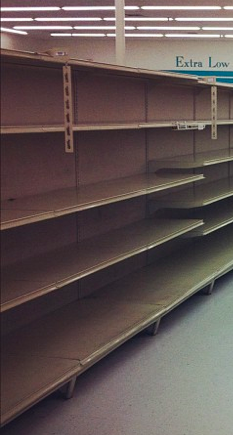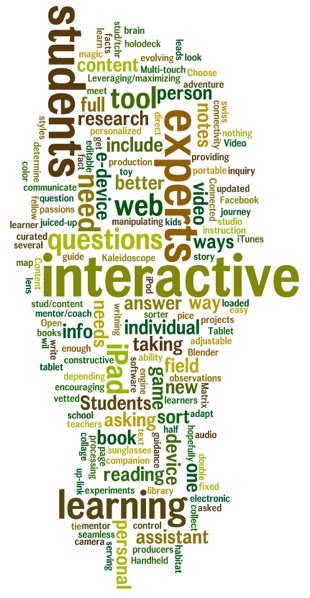I have been invited to participate in Discovery Education’s Beyond the Textbook Forum. I feel quite honored, especially as I’ve scanned the names of other folks who are attending. It will be a special treat to spend some time with Steve Dembo and David Jakes, two talented thinkers and conference speakers.
 |
One thing that struck me about this event is the title. When talking about my dissatisfaction with print-based textbooks, I often ask, “What will textbooks evolve into?” This implies some assumptions, that textbooks, as we know them, will simply morph into something else that acts like a textbook.
The title of this event seems to be asking what the other side of textbooks might look like — and the opportunity of this wide open idea fascinates me.
We’ve been assigned to use our blogs and Twitter to solicit from our readers some ideas about what we might find on the other side of textbooks. As a teacher, I need a simile. I need to be able to say,
“The learning device(s) that our learners will walk into their classrooms with will be more like a ________________.
So, if you don’t mind, would you think for a moment about this task and fill in the text box above with no more than 150 characters that complete the sentence. You’ll notice that I’ve changed your question a bit, “..will behave more like a…”
If you would like to expand on your thoughts, please feel free to post a comment.
Added at 12:17 PM two days later – Here is a word cloud from the similes that have already been posted.


“The learning device(s) that our learners will walk into their classrooms with will be more like Platforms encouraging interactive, more inquiry-based processes.”
The learning device will be an intelligent sorting tool, collecting the latest content and making it available to the student. The device will become the expert, and the traditional teacher will become a partner in the learning process, more of a coach. The challenge/problem will be the bad cop, and the teacher will be the good cop.
Make sure they are accessible by all students. I’m dyslexic and my personal wish list.
1. Be able to customize the font to one that works for me. (Clean, simple but letters like dbp are not mirror images)
2. Be able to customize the background and font colors to a contrast that works for me. If possible an e-ink setting. I love my kindle the gray background and black text work great for me. White background black text turn into 3d objects and fly away.
3. Another reason have an e-ink option is that backlit screens are harder for me to read than e-ink.
4. Not only provide links to other resources, but the ability to do your own research.
@Kimberly, That’s a very good point about the adjustments that have to be made for dyslexia and visual impairments. Hopefully these devices will make it easier rather than harder!
Curriculum content using the current technology will probably look the way the publishers want it to look for now. Depending on how technology advances in the coming years, we can’t predict how curriculum content will look 10 years from now. We can’t even predict how the institution of education will look, for that matter. It will be interesting to see how publishers evolve with the shift in paradigms. Judging by the chaos of eBook formats, the publishing industry needs a serious injection of innovation to stay relevant.
I’d offer up the “palantir” from Tolkien’s Lord of the Rings as an apt metaphor for our next-gen learning devices:
http://en.wikipedia.org/wiki/Palant%C3%ADr
It will allow us to connect and collaborate, and work for both good and evil. There will be struggles over the control of the device, but ultimately each user will need to muster the will, discipline, and skill to use it both effectively and well.
How will the textbook behave? In the short term, like an iPad. Able to record survey responses, accept assignments, communicate with parents. Issued like the many laptop efforts, as with Henrico Cty in Va, but how soon until it’s the desk itself, with students simply logging in with a retina scan or fingerprint? Sounds like science fiction, but in 1912 so did a handheld device with the sum-total of humanity’s knowledge accessible to it.
Imagine further out: 2112. We hear about google glasses as soon as year’s end, and even contact-lenses being not far away; my father has corneal implants to replace his own—-how soon will we figure out how to project data and info there? Add in a motion sensor for how to interact, or imagine a way to tap nerve impulses, and fiction becomes science, and will have applications in he classroom so surely as those Mac laptops in Henrico.
Fascinating.
Best,
Grant
@Grant Mudge,
Hello, I had posted the same thing that textbooks would look like IPads, but for some reason it did not go through.
A Smart board company actually makes a Smart Table that students can interact with the same way they do a Smart board. So, basically, it is exactly like having a desk that is a computer. The only downside is the enormous cost.
I am anxious to see what the technological future has in store for our students.
Carol
Interesting ques. I see something like the cool gadget from NCIS LA where the kids can move,sort,analyze,change data etc. in pockets. The add in would be a filter where they could determine the amount of suggestions or direction they need in organizing the informatio. Kinda like a scale for each grouping where readability and reliability can be identified.
Sunglasses
– filters out information
– passes through reality/augments reality
– hands free operation
– two-way screen (think mirrored on the outside)
– look cool
Like Engelbart’s MotherOfAllDemos. http://en.wikipedia.org/wiki/The_Mother_of_All_Demos
“The learning device(s) that our learners will walk into their classrooms with will be more like a ________________.”
This simile starter is interesting. Many times educators (mediocre ones) do not try to relate the outcome of their classroom to that of the students actual knowledge. To be able to focus on the areas in which the outcome shines through is wonderful. Learners come into our rooms, schools, district offices, and/or forums looking for new insight to the world of education. When they are able to leave with a clear view of what comes next they are extremely happy. With this being said, “The learning device(s) that our learners will walk into their classrooms with will be more like a gateway to the future in which they will control.”
“The learning device(s) that our learners will walk into their classrooms with will be more like a social textbooks where students can interact with other students who are using the textbook and thereby participate in knowledge building.”
This is a great discussion about textbook. Thanks.
“The learning device(s) that our learners will walk into their classrooms with will be more like a second brain.”
What does smart mean in the 21st century? Are you smart because you ‘know’ how to fix a washing machine or are you smart because you google the error code on your washing machine’s display, leading you to a simple tutorial on how to fix it?
As I thought about this question and I read the other comments, I came up with a thought. So, for those who posted ahead of me; thanks for the inspiration.
“The learning devices will allow students to create and embed notes within the actual text document, they will allow students to share and save their notes between and among devices, and they will allow lecture and other media recordings to be embedded within the text document. All of this interactive data will be available for simple mining for studying purposes. These devices will help students study, organize their thoughts, learn, and they will create a permanent searchable record for future use.”
“The learning device(s) that our learners will walk into their classrooms with will be more like a personal guide in the discipline in which they expect to learn. Students will be confident about their abilities thusly and move through the material as such.”
Thank you for the google doc — but I will post here as well:
The learning device(s) that our learners will walk into their classrooms with will be more like indelible ink pen rather than a piece of chalk. Our students will learn that what they post cannot be easily erased.
Hi David,
Isn’t this just a commercial for a digital textbook company, sponsored by said company. I hope they get the desired result out of the folks they will wine and dine.
The entire problem is thinking that “content” (the most vulgar term in education) has anything to do with learning.
Discovery is a cable TV company building a secondary market for sliced-and-diced standards-aligned video clips that they are typically forced to give to schools as a condition of their public license to operate in a municipality. Now the never-ending pot of textbook money may be transferred to them for penguin videos followed by multiple-choice comprehension quizzes and dubious “accountability” systems.
How is it that Discovery has managed to buy a keynote address at most major education conferences, thereby reducing public discourse and amusing ourselves to death. I wonder what Neil Postman would have to say about today’s event?
Dr. Postman would advise those in attendance to strap on their BS detectors and crank them to 11.
I guess the question is throwing me off a little. Maybe we need to rethink “classroom” before we can answer what kind of device students will be using. Just replacing a textbook with some digital device, no matter what kinds of bells and whistles it has, is not the positive education reform that I think so many of us seek. I think there will be a need to curate information that correlates to standards and make this easily accessible to students from any kind of device- from any location. There will be just as much of a need to develop student information and digital literacy skills to find, evaluate, and use information at the point of need.